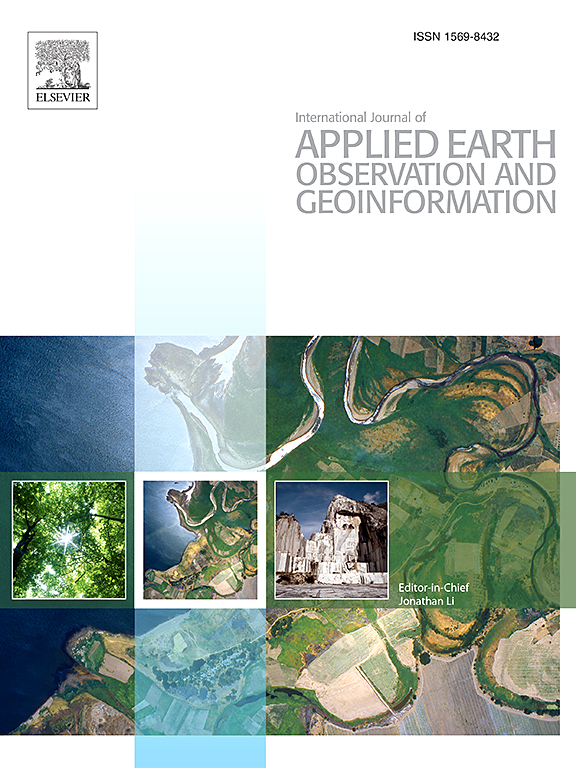CTSeg: CNN和ViT协同分割框架,用于高分辨率遥感图像的高效土地利用/土地覆盖制图
IF 7.6
Q1 REMOTE SENSING
International journal of applied earth observation and geoinformation : ITC journal
Pub Date : 2025-04-28
DOI:10.1016/j.jag.2025.104546
引用次数: 0
摘要
语义分割模型在土地利用/土地覆盖(LULC)制图中具有重要意义。尽管具有长序列相互作用的视觉变压器(ViT)最近与卷积神经网络(CNN)一起成为流行的解决方案,但它们对于以小体积和丰富异质性为特征的高分辨率遥感数据仍然不太有效。在本文中,我们提出了一种新的CNN和ViT协同分割框架(CTSeg)来解决这些弱点。在编码器-解码器架构之后,我们首先引入了具有多种注意机制的编码主干,分别捕获全局和局部上下文。该算法采用并行双支路设计,其中位置关系聚合(PRA)模块和其他具有信道关系(CRA)的模块组成了基于cnn的编码模块,而基于vit的编码模块则由具有跨窗口交互的多级窗移变压器(WST)模块组成。我们进一步探索了在线知识蒸馏,采用像素级和通道级特征蒸馏模块,在精心设计的损耗衰减策略支持下,促进CNN和ViT主干之间的双向学习。此外,我们开发了一个多尺度特征解码模块,以产生更高质量的分割预测,其中杠杆相关加权融合强调异构特征表示。对两个基准数据集进行了广泛的比较和消融研究,证明了其在高效LULC映射方面的竞争力。本文章由计算机程序翻译,如有差异,请以英文原文为准。
CTSeg: CNN and ViT collaborated segmentation framework for efficient land-use/land-cover mapping with high-resolution remote sensing images
Semantic segmentation models present significant work in land-use/land-cover (LULC) mapping. Even though vision transformers (ViT) with long-sequence interactions have recently emerged as popular solutions alongside convolutional neural networks (CNN), they remain less effective for high-resolution remote sensing data characterized by small volumes and rich heterogeneities. In this paper, we propose a novel CNN and ViT collaborated segmentation framework (CTSeg) to address these weaknesses. Following the encoder-decoder architecture, we first introduce an encoding backbone with multifarious attention mechanisms to respectively capture global and local contexts. It is designed with parallel dual branches where the position-relation aggregation (PRA) blocks and others with channel relations (CRA) form the CNN-based encoding module, whereas the ViT-based one comprises multi-stage window-shifted transformer (WST) blocks with cross-window interactions. We further explore the online knowledge distillation presented with pixel-wise and channel-wise feature distillation modules to facilitate bidirectional learning between the CNN and ViT backbones, supported by a well-designed loss decay strategy. In addition, we develop a multiscale feature decoding module to produce more high-quality segmentation predictions where the leveraged correlation-weighted fusions emphasize the heterogeneous feature representations. Extensive comparison and ablation studies on two benchmark datasets demonstrate its competitive performance in efficient LULC mapping.
求助全文
通过发布文献求助,成功后即可免费获取论文全文。
去求助
来源期刊

International journal of applied earth observation and geoinformation : ITC journal
Global and Planetary Change, Management, Monitoring, Policy and Law, Earth-Surface Processes, Computers in Earth Sciences
CiteScore
12.00
自引率
0.00%
发文量
0
审稿时长
77 days
期刊介绍:
The International Journal of Applied Earth Observation and Geoinformation publishes original papers that utilize earth observation data for natural resource and environmental inventory and management. These data primarily originate from remote sensing platforms, including satellites and aircraft, supplemented by surface and subsurface measurements. Addressing natural resources such as forests, agricultural land, soils, and water, as well as environmental concerns like biodiversity, land degradation, and hazards, the journal explores conceptual and data-driven approaches. It covers geoinformation themes like capturing, databasing, visualization, interpretation, data quality, and spatial uncertainty.
 求助内容:
求助内容: 应助结果提醒方式:
应助结果提醒方式:


